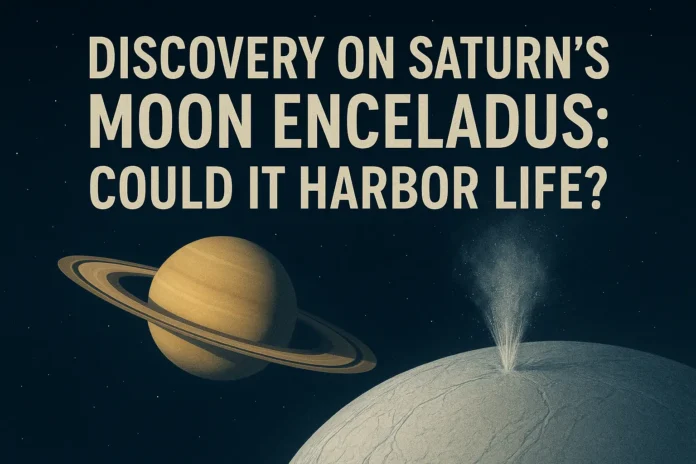Scientists have found new evidence that Saturn’s icy moon Enceladus contains all the essential ingredients for life. Recent studies confirm that the underground ocean beneath its frozen surface holds complex organic molecules — the building blocks of life itself.
A Breakthrough in Space Exploration
Almost two decades ago, NASA’s Cassini spacecraft made one of the most astonishing discoveries in planetary science: beneath Enceladus’ thick layer of ice lies a global subsurface ocean. The spacecraft also detected geysers — massive plumes of water vapor and ice — erupting from the moon’s south pole. These geysers not only spewed material into space but also formed Saturn’s famous E ring.
At first, scientists wondered whether the material in those geysers originated from the moon’s surface or deeper within. Now, new findings published in Nature Astronomy provide a clearer answer: the complex organic molecules come directly from Enceladus’ hidden ocean.
What Exactly Was Found?
The research team analyzed data from Cassini’s Cosmic Dust Analyzer (CDA), which examined ice grains traveling at 18 kilometers per second. These grains contained a wide variety of molecules, including those with carbon, nitrogen, and oxygen — the key elements of life.
In earlier studies, scientists detected simpler “prebiotic” compounds, such as amino acids. But there was always uncertainty about where they originated. This new analysis leaves little doubt: the molecules are native to Enceladus’ ocean and not just surface contamination.
Dr. Jörn Helbert of the European Space Agency emphasized:
“For the first time, we have direct proof that these complex molecules truly belong to Enceladus’ ocean. This means we now know the moon possesses the chemical ingredients necessary for life.”
Does This Mean There Is Life on Enceladus?
The discovery is exciting, but scientists remain cautious. The ingredients for life — liquid water, energy sources, and organic chemistry — are all present. But whether life has actually emerged on Enceladus is still an open question.
Helbert explains:
“We cannot say if life exists there. But we can say with confidence that all the right materials are in place. This makes Enceladus one of the most promising places in our solar system to search for extraterrestrial life.”
This puts Enceladus alongside Europa (Jupiter’s moon) and Mars as leading candidates for habitability beyond Earth.
Why Enceladus Is So Special
What makes Enceladus even more intriguing is easy access to its ocean. Unlike Europa, which has an ice crust tens of kilometers thick, Enceladus vents water directly into space through its geysers. This means future missions won’t need to drill through ice to reach samples — they can simply “fly through” the plumes.
This unique feature dramatically increases the chances of detecting biosignatures, if they exist.
Future Missions: Enceladus in the 2040s
The European Space Agency (ESA) is currently designing a dual-phase mission to Enceladus, scheduled for launch in the 2040s. According to early plans:
- One spacecraft would orbit Enceladus, performing long-term surveys.
- Another lander would descend to the “Tiger Stripes” — the massive fissures near the south pole where the geysers erupt.
If all goes according to schedule, the mission could reach Enceladus by the 2050s. For many scientists, this decades-long wait will be worthwhile: it would mark the first direct exploration of an alien ocean.
A Step Closer to Answering the Biggest Question
Humanity has always wondered: Are we alone in the universe? Discoveries like this bring us one step closer to answering that question. Enceladus has transformed from a small, overlooked moon into one of the prime locations in the solar system for finding extraterrestrial life.
Dr. Carolyn Porco, who led Cassini’s imaging team, once described Enceladus as “a tiny icy moon that may hold the secrets of biology itself.” Today, that statement feels more accurate than ever.
The Bigger Picture: Why It Matters
This discovery isn’t just about one moon. It reshapes how we think about habitability in the universe. Life may not require an Earth-like planet with surface oceans and sunshine. Instead, it may thrive in dark, hidden oceans beneath ice crusts, powered by hydrothermal vents — just like the ecosystems found deep in Earth’s oceans.
If life exists on Enceladus, it would suggest that the universe could be teeming with habitable environments, far beyond what we once imagined.
Conclusion
Saturn’s icy moon Enceladus continues to astonish scientists. With liquid water, organic chemistry, and energy sources, it meets every known requirement for life. While the question of actual life remains unanswered, upcoming missions may provide the final proof.
For now, Enceladus stands as one of the most important frontiers in the search for life beyond Earth.



